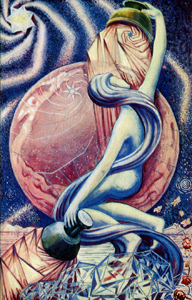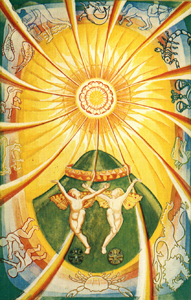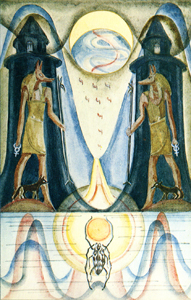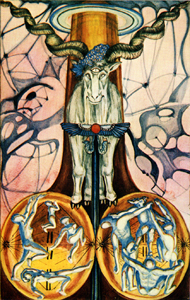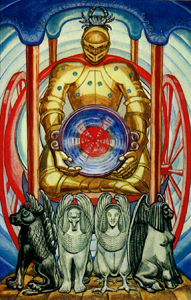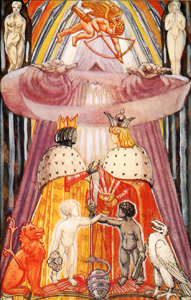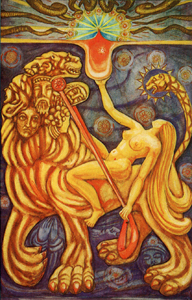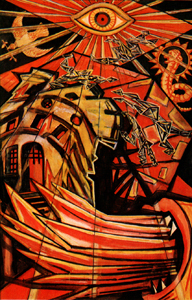
Atu XVI is commonly called “The Tower” or more fully “The Blasted Tower”. My own chosen alternate title would be “The Crumbling of The Prison Walls” or more simply “The Broken Prison”. The key idea is that An Established Stable Edifice becomes Utterly Destabilized! The stability of this established edifice is our own conviction in the certainty of our given sensory data. Things Are What They Are, according to our senses; and their apparent consistency encourages our conviction in that certainty. Wobbles of that certainty are what is usually called “delusion” or “illusion” — and never for a moment is that panorama of sensory-convinced consistent certainty ever considered the “actual illusion” or “actual delusion”. Such a consideration would be utterly unnerving for “ordinary living”.
But remember, all Tarot freaks, that Atu XVI is well advanced in the Trump Series. We have gotten well beyond “ordinary living”. The ‘later’ pages (cards) of the Trump Series deal with describing factors necessary-of-consideration for those who have “done work” on themselves. Atu XVI deals with the awful revelation of The Delusion of One’s Own Self-Crafted Prison Walls. The effect does come off like “a force on-high” “descending” and “devastating the solid edifice” “below”. (The ‘above/below’ metaphor is an antique left-over.) The full effect does not require your actual Sensory Perception to “become wobbly”. The devastation is in Your Conviction of ‘Its’ Certainty. In its essence it is A Drastic Change of Mind and Attitude, and the “revelation” is equivalent to “an onslaught”. For those Addicted to Certainty, it would feel like “a violation” and “a violence”. The “breaking” of these “prison walls” is in the otherwise ordinary underlying belief in their certainty. These “prison walls” can still maintain their ‘ordinary appearance’ during this mental conversion. What is “destroyed” or “disturbed” is the resident comfort of their certainty; and the awful cognizance that “what is called real” IS a “curtain” or “veil”. And this revelation does not even have to take on ‘metaphysic’ proportions: the simple comprehension that “the perceptual curtain” is composed of only a portion of the total potential signal-energy output of even every “physical” manifestation, is sufficient.
So, when this card appears in an “ordinary reading”, the reader should be compelled to break the news to the client that some “sacred cow of certainty” is at risk. The usual tactic appears to have been to merely give some ‘frightening trepidation’ about “a violation”, without indicating “the real victim” of “this violation” — a sacredly-held ‘certainty’. For those readers who have dared such, I applaud you.
All of this gives a clue as to why I question the now-classic attribution of this page (card) to only the astrological planet Mars. The much more preferable attribution would be directly that of the astrological planet Pluto. Pluto may be commonly given the metaphors of “death & resurrection”, but the seed idea is that of “transformation” — and, especially read “TransFormation”. The “death & resurrection” metaphors are attempts to give markers-of-definitiveness to a process that rather actually reeks of “in-between-ness”. And it is not unwarranted to say that when the Sense of Certainty has “been violated” or becomes rather abrogate, a feeling of “in-between-ness” ensues. In the Trump Series, Atu XVI represents when the Construct of Certainty has been Torn Asunder, but as yet no “alternative” has been offered (that is the ‘later’ Trumps).
(There are those who also associate the astrological planet Uranus to this page (card), which I cannot wholly disagree yet for one key exception, that I tend to view Uranus as much more ‘purely’ of ‘mental’ orientation — the archetype of “Change Your Mind” in-and-of-itself.)
To me, the astrological planet Mars is much more appropriately associated with Atu IV “The Emperor”. The now-classic astrological attribution to Atu IV is the zodiacal sign Aries; which in my outlook is also valid. Mars is in its core a rather “defiant” stance of “Selective Independence”. There is an insistence on “Me, Myself, and I” (the three ‘truly’ best friends). But this “defiant” stance of Mars is not a matter of ‘pushing away others’; it is simply the extreme perspective of Insisting on Self. Both Mars and Atu IV are merely the notion of “in the wholistic context of Nature, What Is My Place?” Atu IV is the “awful” revelation of a cognizant entity, co-involved in the collective concourse of Nature, to dare to ask such an heretical question as “how do I fit into all this?” Atu IV is distinguished from Mars due to ‘the animal factor’ (of which ‘the human factor’ at this stage is a sub-set).
The core idea of Mars as “Selective Independence” becomes rather abrogate with Atu XVI. “Selective Independence” requires a Sense of Certainty in that notion of “Independent Existence”; a ‘Sense of Certainty’ in that ‘Sense of Separation’ from the surrounding ‘Co-existing Context of Nature’. Atu IV is the most primal act of “I Am I”. With Atu XVI, the sense of “I Am I” is not violated. What is violated at Atu XVI is any certainty of “what is this that Surrounds ‘I’?” What is violated at Atu XVI is “how do I define what Separates ‘I’ from the rest of the surrounding?”
As those who are consistent with “wholistic cognition” do cognize, eventually that “sense of separation” evaporates. But not yet here at Atu XVI.

O-A-Hum
OPD
[added May 15]
There is another factor, concurrent but only appears to be a ‘separate’ consideration.
The devastation of “The Blasted Tower” is very much connected to the Separation of Identification with One’s Temple-Shell. The “Be Here Now” of Atu XIX is the completion of this indicated separation; Atu XVI is the so-called ‘real beginning’ of this separation. To use metaphors from cinematic stories, Atu XVI is The Initial Unplugging from The Matrix, and The Separation from The Avatar. You cease to attach your Sense of Identity with the Vessel, the Machine, the Vehicle that You Are Piloting or Driving. Then, the statements such as “IT Moves” and “IT Feels” and “IT Thinks” become actual, and not merely novel notions. All external descriptions of this attitude pale in comparison to actually experiencing this attitude.
There is yet another concurrent factor, even ‘weirder’ than the above.
There is a genuine sense of how All The Surrounding Construct is A Collection of Information. The “Tower” Crumbles not because chunks of material mutually separate and dissociate from each other — the bodily form remains intact. It is “the reality” of those ‘building blocks’ and of ‘the overall structure’ that is utterly thrown into question, the Sense of Their Stability. To have the vision of how All This is “Congealed Information” is more devastating to The Old Sensibility than can be imagined for ‘ordinary living’. You do not question the movements and happenings of “reality”; but while you observe yourself and your surroundings, your “view” of it has been drastically altered. And it is a “view” that cannot be shared with others, unlike when two people can point to a rock and agree on ‘its’ existence — even if you happen to be with another who also has shifted “view”. I that case, at best, the two “view”-shifted individuals can mutually chuckle over the “it’s just information” humor.
